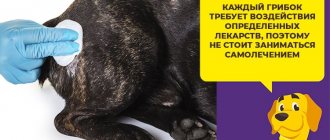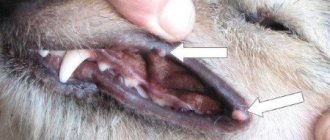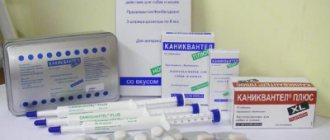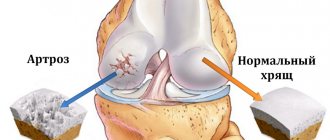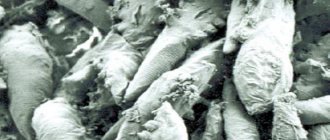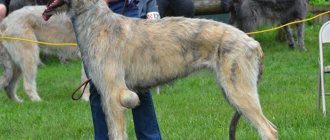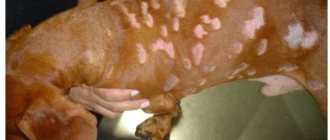Composition and release form
The vaccine contains 8 different fungi from the genus Microsporum and Trichophyton, so it creates immunity against various types of dermatomycosis, as well as lichen, which is transmitted to humans. Externally, Polivac is a light brown injection liquid. A distinctive feature is the presence of sediment that appears during storage. With gentle shaking it dissolves easily.
Polivak is packaged in sterile transparent glass bottles, which are sealed with rubber stoppers and covered with foil. One vial contains one dose of vaccine. Usually 10 bottles are placed in a cardboard package.
Polivak-TM is available for dogs and cats. Choose the drug according to the intended purpose, since the bottle contains a dose for a specific animal species.
Pharmacological properties and indications for use
After a two-time administration of the drug at a time interval, immunity to fungi such as Trichophyton and Microsporum is formed in the animal’s body in 20-30 days. It persists for 12 months, and after that it is necessary to re-vaccinate.
According to the instructions, Polivak-TM is used for dogs in the treatment of ringworm, as well as to prevent their occurrence. Many pets face these diseases, including those who spend most of their time in an apartment or house. If measures are not taken in time, the lichen or fungus can become chronic, which will affect the overall health. The following symptoms indicate the appearance of dermatomycosis:
- baldness;
- redness of bald areas;
- itching;
- peeling of the skin, etc.
If you notice such symptoms, do not rush to administer the vaccine. Consult your doctor first, as the drug has contraindications.
Dermatomycosis of dogs and cats: treatment with the POLIVAC-TM vaccine
Dermatomycosis of dogs and cats is a frequently occurring contagious zoonotic disease of the skin and hair of animals in various countries of the world.
The spread of this disease occurs through the transmission of the pathogen from a sick animal to a healthy one through direct contact or through care items. It is also possible to transmit the pathogen through various environmental objects and through humans.
The causative agents of animal dermatomycosis belong to two genera of fungi: the genus Trichophyton and Microsporum. The most common pathogens of animals are Trichophyton mentagrophytes, T. Verrucosum and Microsporum canis among zoophilic dermatophytes and Microsporum gypseum among geophilic ones.
Dogs and cats are most often affected by the pathogen Microsporum canis, sometimes by its subspecies Microsporum canis var.distortum, Microsporum canis var.obesum, as well as Microsporum gypseum and Trichophyton mentagrophytes. Other pathogens of dermatomycosis are isolated from dogs and cats extremely rarely.
Until recently, the main method of treating dermatomycosis of various animal species, including dogs and cats, was the cutaneous application of various ointments containing fungistatic and fungicidal substances (imidazole compounds, salicylic acid, sulfur and others) or oral administration of the antibiotic griseofulvin or ketocanazole. Recently, the drug Terbinafine (Lamisil) has become widespread, especially for the treatment of dermatitis in humans.
In addition to the lack of effectiveness of antifungal drugs for local and systemic treatment, in our opinion, they also have the following disadvantages:
- For local treatment:
- Daily use of the drug for at least 1 month,
- Inability to identify all affected areas;
- Possibility of poisoning an animal with toxic drugs when licking them from the application site;
- Impossibility of effective prevention of the spread of dermatomycosis (in the case of keeping several animals together).
- For oral systemic treatment:
- The need for long-term use of antifungal agents (1 month or more);
- Toxic effect;
- The need to monitor the general clinical condition of the animal due to a possible side effect of the antifungal drug.
Many years of experience in the treatment of dermatomycosis of various animal species have shown that the most effective is the use of specific methods, i.e. use of vaccine therapy and vaccine prophylaxis. the use of specific methods of treatment and prevention makes it possible to quickly stop the spread of skin lesions, in the case of a latent course of the disease, to identify foci of lesions and prevent relapses of the disease.
Taking into account the above-mentioned disadvantages of local and systemic methods of treating animals, as well as the positive experience of using live vaccines for the prevention of trichophytosis in cattle - LTF-130, for the prevention and treatment of trichophytosis in horses - S-P-1, for the prevention and treatment of trichophytosis in fur-bearing animals - MENTAVAC (Sarkisov A.Kh., Petrovich S.V., Nikiforov L.I. 1971; Sarkisov A.Kh., 1987; Petrovich S.V., 1987; Nikiforov L.I., 1987). We have created inactivated vaccines for the prevention and treatment of dermatomycosis in animals, in particular dogs and cats.
The Polivak-TM vaccine had the following positive properties:
- Selected immunogenic and technologically advanced strains were used for preparation;
- the strains used to prepare the vaccine have stable antigenic, pathogenic and other biological properties;
- standard vaccine preparation technology;
- the vaccine is polyvalent, has an optimal set of strains of pathogens of dermatomycosis;
- the vaccine is inactivated and is not dangerous for people and animals that come into contact with vaccinated animals;
- The vaccine is harmless and highly effective.
The main direction in vaccinology is the creation of vaccines, primarily with preventive properties. The created vaccine has, in addition to preventive properties, a pronounced therapeutic effect.
Preclinical studies have shown that immunization with the Polivak-TM vaccine causes the formation of specific antibodies that belong to the IgA and IgM classes, while the formation of IgG was not observed. However, the formation of IL-10 was also noted, which is characteristic of the development of a Th2 immune response. The production of this interleukin in turn stimulates the proliferation of T-suppressor cells, which prevent an overreaction. The development of specific delayed-type hypersensitivity confirmed the stimulation of the Th1 immune response.
The immunogenic effectiveness of the Polivak-TM vaccine with experimental infection was tested on 90 cats and 77 dogs in nurseries and vivariums. The animals were infected at different times after vaccination - 30-35 days; 87 95 days; 172-185 days; 350 - 370 days.
As a result of cutaneous infection, most animals were immune to infection by virulent dermatophyte cultures. In parallel, the safety of the vaccine was tested under experimental conditions on the same animals.
Administration of standard doses of the Polivac-TM vaccine against ringworm to animals did not lead to a change in the clinical condition. The animals retained their appetite, there were no changes in behavior, and there was no local reaction, which confirmed the harmlessness and reactogenicity of the vaccine.
Thus, as a result of the studies, the immunogenic activity of the Polivak-TM vaccine was shown through cutaneous infection of vaccinated animals with virulent fungal cultures, and also the immunobiological restructuring of the animal body after vaccination was revealed in in vitro, ex-in-vitro reactions and delayed-type allergic reactions (in vivo ).
Field testing of the Polivac-TM vaccine was carried out on a large population of dogs and cats in Moscow, St. Petersburg and Tashkent.
The vaccine was tested on more than 2,500 dogs and cats.
In one of the clinics, 180 animals were immunized. of these, 67 cats and 42 dogs were treated for therapeutic purposes and 48 cats and 23 dogs for prophylactic purposes.
As a result of the tests, the harmlessness of the vaccine was confirmed. Only 3 dogs out of all treated animals had a local reaction.
During a clinical examination of the animals 25-30 days after the second vaccination, complete rejection of crusts at the site of ringworm lesions and hair growth on damaged areas of the skin were observed in all animals.
Increased lesions were noted in 12 cats and 8 dogs with dermatomycosis after the first injection of the vaccine and in 6 cats and 7 dogs with dermatomycosis after the second injection of the vaccine. The third administration of the vaccine did not stimulate the clinical manifestations of the disease.
The occurrence of dermatomycosis lesions after administration of the vaccine was detected in 10 cats and 5 dogs. We consider this phenomenon as a provocation of the disease. After vaccination, as shown by previous experiments with delayed-type allergy tests, after 5 days it is possible to detect immunobiological changes in the animal’s body. Therefore, after such a short time, the body can recognize “self and foe” and react by rejecting the tissues affected by the fungus, and, accordingly, the fungus.
Forty-eight cats and 23 dogs were followed for 10-12 months after immunization. All animals immunized for prophylactic purposes did not develop dermatomycosis within 10-12 months after immunization. Similar results were obtained in other clinics where the Polivak-TM vaccine was tested.
Widespread use of the Polivak-TM vaccine has revealed a decrease in effectiveness to 70 - 75% in some large cat breeding nurseries. An analysis of the epizootological situation in these nurseries, the type of housing and level of feeding showed that in animals exhausted by constant malnutrition, the effectiveness of vaccination decreases. Crowded housing of animals, for example, 20-30 cats in a 2-3 room apartment, also reduces the effectiveness of vaccination by up to 75% and contributes to the very rapid spread of the disease in such a nursery.
Viral chronic diseases, especially those associated with an immunodeficiency state, can reduce the effectiveness of vaccination against ringworm.
I would especially like to draw attention to diseases associated with all kinds of skin lesions from mites. The effectiveness of vaccination in animals affected by ectoparasites is also usually reduced.
In Russia, a joint production of the Polivac vaccine has been organized for use in wide veterinary practice.
As a result of scientific research and positive results of clinical trials of the Polivak-TM vaccine, it was possible to introduce it in other countries. About 50% of sick dogs and cats, and about 70% of sick horses with ringworm in Germany are treated with this vaccine every year. The vaccine is also used for prophylactic purposes. The production of the vaccine is carried out according to European standards (E11
CONCLUSION
- vaccine therapy and vaccine prevention occupies the main place among the methods of combating animal dermatomycosis;
- the vaccine Inzol® Dermatophyton, an analogue of Polivak-TM, was registered for the first time and is widely used in the countries of the European Community;
- the use of the Polivak-TM vaccine for the prevention and treatment of microsporia in cats and dogs reduces the risk of the spread of this zoonosis;
- a technology has been developed for the production of a harmless and immunogenic vaccine for the treatment and prevention of dermatomycosis in animals, including dogs and cats;
- joint production of a high-quality vaccine has been established;
- the Polivak-TM vaccine causes significant immunobiological changes in the body of animals by stimulating the formation of specific antibodies of the IgA and IgM classes.
Liebherr service center: Liebherr repairs. High quality and inexpensive
Dosage
Vaccine doses depend on two factors - the age of the pet and the purpose of use (prevention or treatment). All dosages of Polivak-TM for dogs are prescribed in the instructions for use. If the drug is used to prevent the disease, it should be administered to puppies and adults in a volume of 0.3 ml. The vaccine is administered once, and if there is a high risk of infection, the procedure is repeated after 14 days.
When using a medication for treatment, the doses should be as follows:
- for puppies aged 1 to 10 months – 0.5 ml;
- for pets over 10 months – 0.6 ml.
Vaccination is carried out 2 or 3 times with an interval of 10-14 days, depending on the degree of infection, existing symptoms and the individual characteristics of the animal.
Indications for use, method and dosage
Prevention and treatment of dermatomycosis in representatives of the cat family. In common parlance, this skin disease is called “lichen.” Not only outdoor cats, but also domestic cats can become infected with it. This phenomenon can be explained quite simply: the infection can be transmitted on the owner’s clothing and through care items. Therefore, an annual preventive vaccine is strongly recommended by veterinarians.
For cats under 5 months of age, the recommended dose for prevention is 1 ml., for treatment is 1.5 ml.
For cats older than 5 months, the recommended dose for prevention is 1.5 ml., for treatment is 2 ml.
When treating the disease, the vaccine is used 2–3 times every 2 weeks. Prevention is carried out once a year. Before the procedure, the injection site is treated with 70% alcohol, and the bottle is shaken. A separate syringe should be used for each pet.
How to use?
The drug should be administered intramuscularly. Injections can be given in the following places:
- hind leg thigh;
- spatula;
- neck.
When carrying out vaccination, the following sequence of actions should be followed:
- Shake the bottle lightly to distribute the sediment evenly.
- For injection, use a disposable sterile syringe. Reusable needles should be boiled well before use.
- Puncture the rubber stopper and draw the liquid into the syringe.
- Be sure to wipe the injection site with alcohol or carbolic acid solution.
- Gently inject the drug into the muscle tissue.
A veterinarian's examination is required before injection.
If an animal suffers from ringworm, emollients should be used to speed up the exfoliation of damaged areas and tissue regeneration. Fish oil, lanolin, petroleum jelly or other oils used in veterinary medicine are perfect for these purposes. Oils should be applied to damaged areas several times a day.
It is necessary to take into account that when infected with ectoparasites or worms, as well as metabolic disorders, the effectiveness of the product is significantly reduced.
Dosage calculation and vaccination schedule
In the section on taking the drug Polivak TM for cats, the instructions recommend:
- For babies from 1 to 5 months, administer 1.5 ml;
- over five months - 2 ml of the product.
To prevent accidental infection of a furry pet, the drug is administered:
- kittens from 1 to 5 months - 1 ml;
- over five months - 1.5 ml.
Vaccine injection
Before carrying out the procedures, the pet should be shown to a veterinarian and obtain his approval. Cat owners who decide to pierce the product themselves must adhere to the following rules:
- in order not to reduce the effectiveness of the medication, it should not be injected into exhausted and flea-infested animals;
- the injection is carried out in the femoral part of the hind paw;
- a gap of two weeks is maintained between two injections;
- the injection site is wiped with a cotton pad soaked in an alcohol solution or antiseptic;
- for manipulation it is better to take a disposable insulin syringe with a thin needle;
- Before taking the medicine, shake the bottle thoroughly;
- after opening, the solution is not stored, as it loses its beneficial properties;
- Immediately before the injection, the ampoule is warmed in your hands.
If there are several animals in the house, and one of them has become infected with lichen, then, in addition to treating the sick individual, preventive therapy is carried out for all the others. Young animals can be transported from the nursery 14 days after the procedure.
Note! If an animal is admitted to a nursery, it is sent to quarantine and given a preventive injection against lichen.
Contraindications and side effects
Polivak-TM for dogs cannot be used in the following cases:
- if the animal is weakened;
- when infected with infectious diseases;
- at elevated temperatures.
If the drug is used during the incubation period, the symptoms of the disease may become more pronounced. To avoid complications and unwanted reactions, the animal should be shown to a doctor.
Polivac usually does not cause side effects and is well tolerated by pets. In rare cases, the following may appear at the injection site:
- swelling;
- edema;
- redness.
When touched, the dog may experience pain, but such side effects do not require treatment. They pass without a trace in just 3-4 days.
How to use Polivak TM for dogs
The instructions inform about compliance with the mandatory conditions for vaccination with the drug: the absence of fever and infectious diseases in dogs.
Before administering the drug to pets, the bottle of medication must be shaken to ensure uniformity of the liquid, and then drawn into an insulin syringe. The injection is given to the dog's hind leg muscle. Polivac TM vaccination is carried out twice, and the second injection of the drug is administered 10-14 days after the first. The procedure is carried out in compliance with the rules of sterility and asepsis. It is imperative to disinfect the skin in the area where the medication is administered with ethyl alcohol or a 0.5% solution of carbolic acid.
The dosage of the vaccine depends on the age of the dog. Thus, puppies from 1 to 10 months are administered a single dose of 0.3 ml of the drug for prophylactic purposes, and 0.5 ml for therapeutic purposes. For young pets over 10 months old, 0.3 ml is administered for prophylactic purposes, and 0.6 ml for therapeutic purposes. When using Polivak TM purely for therapeutic purposes, the drug is administered three times with an interval of ten days. To speed up the treatment and rejection of skin affected by the fungus, it is recommended to treat it with petroleum jelly, lanolin, fish oil, vegetable or mineral oils, while wearing gloves.
Veterinary practice demonstrates that when healthy bitches and males are vaccinated, no changes in their condition, that is, side effects, are observed. Sometimes, after the vaccine is administered, dogs may experience slight swelling of the skin at the injection site of Polivak TM. But this does not require any therapeutic measures and goes away spontaneously after 48-72 hours.
When it comes to vaccination for an animal that is in the incubation period of the disease, it will accelerate its manifestation. In such cases, dogs must be given the vaccine three or four times.
Since the administration of the drug during the incubation period of dermatomycosis contributes to their clinical manifestations, mass vaccination of dogs in therapeutic doses is carried out in nurseries. If animals have metabolic disorders, the effectiveness of vaccination decreases. Dogs brought to kennels are vaccinated during the quarantine period.
So, the use of a domestically produced drug helps protect dogs from dermatomycosis. Veterinarians remind: the optimal and effective treatment is prevention. Therefore, it is better to vaccinate a dog than to treat it for contagious dermatological diseases.
Storage rules and special instructions
When carrying out vaccination, you should use rubber gloves and follow the rules of asepsis. If injections are administered to several dogs, a separate sterile syringe should be used for each pet.
The vaccine should be stored at a temperature of 2 to 10˚C away from sunlight. A refrigerator is perfect for these purposes. The shelf life is 1.5 years, after its expiration it is prohibited to use the drug. Also, the use of the vaccine should be abandoned in the following cases:
- the seal of the packaging is broken;
- there are no expiration dates, composition or other information on the bottle;
- there is mold or foreign matter in the liquid.
If the drug cannot be used, it must be neutralized by boiling for 15 minutes. If the vaccine is not completely used, the remainder of the bottle must also be boiled. The bottles should be thrown away. They cannot be used for domestic purposes.
Owner reviews
Gregory, owner of the Afghan hound:
“From the experience of a friend, I know what consequences lichen can lead to. My Afghan Hound participates in various exhibitions every year, and its coat is its main advantage. In this regard, I regularly use Polivac for prevention. The dog tolerates the vaccination well.”
Anastasia, pug owner:
“After the move, the dog began to shed heavily. The veterinarian recommended a vaccine to prevent dermatosis. The first time they injected Polivac for dogs, and the second time for cats. After this, a fistula formed at the injection site, which we have not been able to get rid of for three weeks. I don’t know who is to blame – the drug or the incompetent doctor who gave the wrong injection.”



